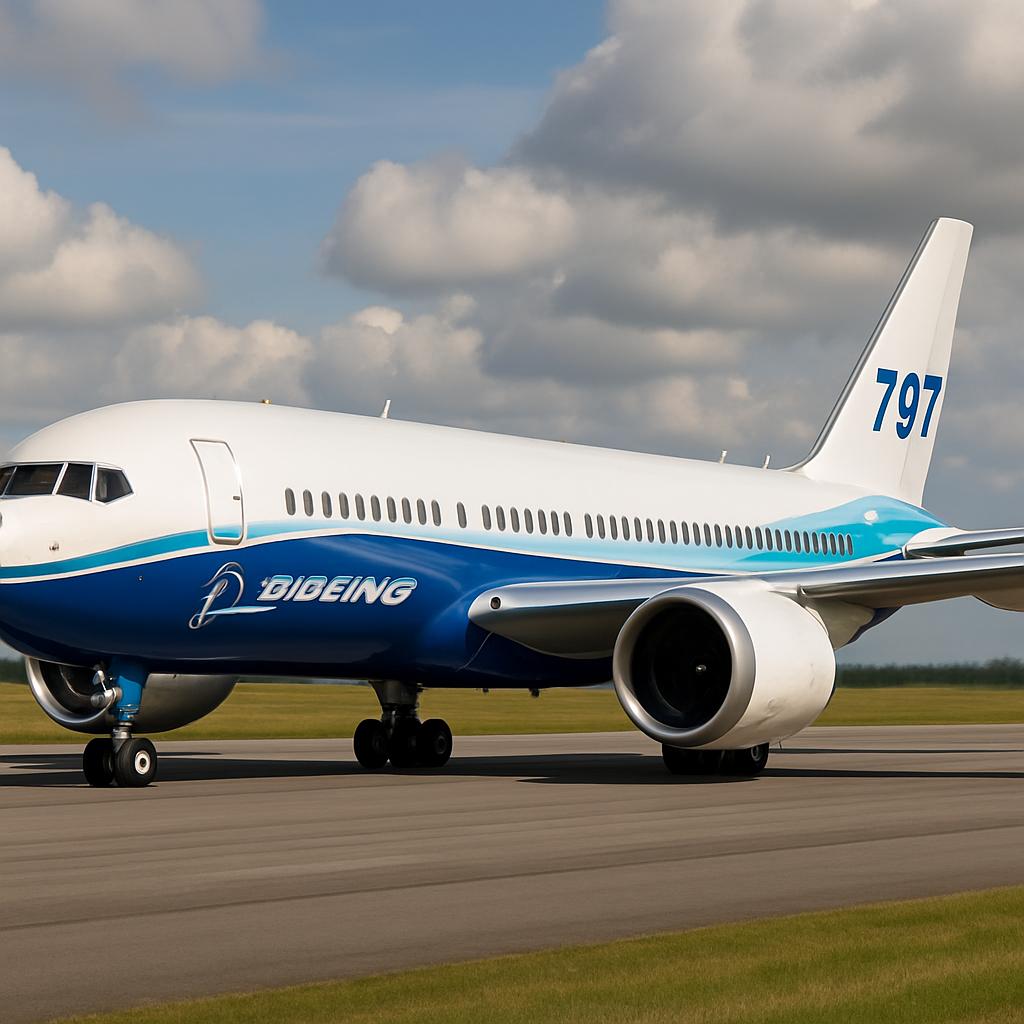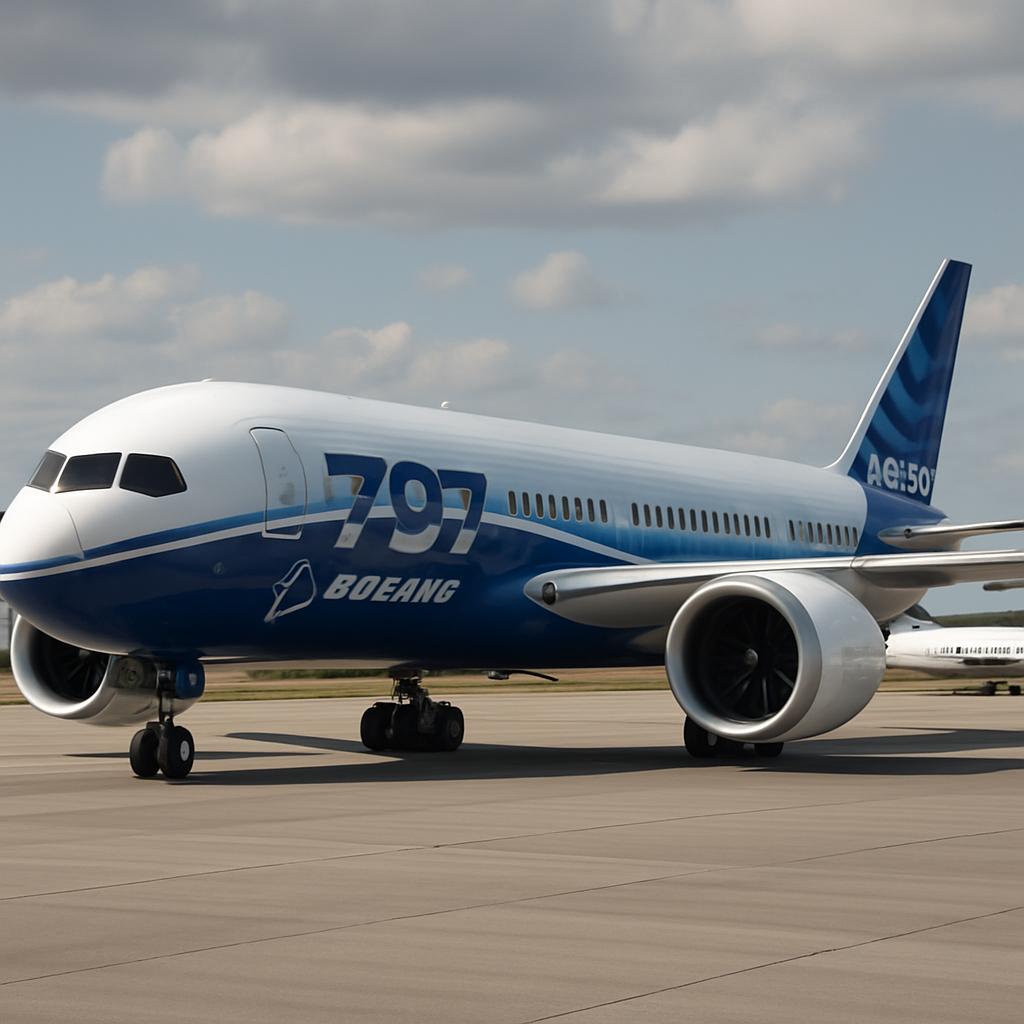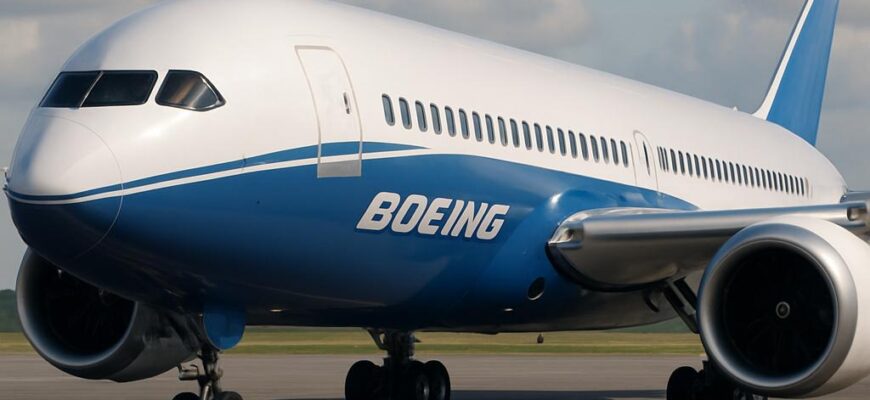What we know about the Boeing 797: Boeing’s potential new aircraft remains a topic of industry fascination and careful skepticism. The designation “797” has become shorthand in aviation coverage for whatever shape Boeing’s answer to the so-called middle of the market will take. Facts are thin, speculation is thick, and every corporate statement or patent filing sends analysts and airlines into a flurry of recalculations.
- Why the middle of the market matters now
- The history: from NMA to 797 rumors
- What Boeing has said (and what it hasn’t)
- Design possibilities: more than one way to fill the gap
- Passenger experience: what airlines and travelers want
- Engines: the technical heart of fuel efficiency
- Manufacturing and supply chain realities
- Regulatory environment and certification pressures
- Competition: Airbus and the evolving market landscape
- Economic model: can Boeing make the numbers work?
- Operational considerations for airlines
- Environmental impact and sustainability expectations
- Timelines: when could a 797 appear?
- Possible specifications: what analysts talk about
- Risk factors Boeing must manage
- What airlines are saying privately
- Lessons Boeing might apply from past programs
- Supply chain partners and their stakes
- How leasing companies factor into the decision
- Market sizing and demand forecasting
- Cabin innovation and passenger comfort features
- Operational examples that illustrate demand
- What will determine a launch decision?
- What to watch next: signals that matter
- Comparing alternatives: a brief table
- How pricing might look
- Potential geopolitical and trade impacts
- Future-proofing: upgrade paths and technology insertion
- How investors view the opportunity
- What passengers might experience if the plane is built
- How the aftermarket will be built
- Community reaction: pilots, unions, and other stakeholders
- Unanswered questions that will shape the debate
- How to follow developments and what sources matter
Why the middle of the market matters now

The airline network has shifted in the last decade toward many more long, thin routes that don’t justify a widebody but outstrip the capabilities of today’s single-aisle jets. Airlines want to open direct routes between secondary cities, and they prefer fewer connections for premium passengers. That gap—the middle of the market—has become commercially significant because it promises higher yields on routes that are currently served by inefficient connections or by larger jets with too many seats.
Airbus has responded to some of those needs with the A321XLR, which stretches the narrowbody concept to longer ranges and higher capacity. The A321XLR buys airlines transatlantic flexibility at relatively low cost, but it also exposes comfort and payload limits on longer missions. Boeing’s strategic calculus has been whether to compete directly with more capable narrowbodies, to resurrect the idea of a purpose-built midmarket twin, or to pursue something entirely different.
The history: from NMA to 797 rumors
Boeing’s work on a middle-market jet is not new. The New Midsize Airplane (NMA) program—discussed intensively in the late 2010s—was essentially a formal study into a 220–270 seat aircraft filling the gap between narrowbodies and widebodies. That program explored many configurations, suppliers, and engines, and it generated strong interest from airlines and leasing firms who wanted a clean-sheet product tailored to those route economics.
But NMA never reached a launch decision. In part, Boeing’s focus shifted to resolving quality and certification issues surrounding the 737 MAX and to completing the troubled 787 and 777X programs. The “797” moniker has persisted in media and analyst reports as shorthand for any revived midmarket project, even though Boeing has not committed to a formal 797 program in public filings. What remains are internal studies, supplier conversations, and a marketplace that continues to ask for a better solution.
What Boeing has said (and what it hasn’t)
Boeing’s public messaging has been cautious. Executives have acknowledged the middle market as an important long-term segment, but they have been careful not to promise timing or technical specifics. Official language emphasizes continued analysis, customer engagement, and alignment with market demand rather than a firm launch schedule or a finalized design.
The absence of a clear public commitment is meaningful. Aircraft programs require massive investment, risk-sharing with suppliers, and a long lead time to deliver credible performance and compliance. Boeing has been signaling that a program launch would depend on stable market forecasts, convincing airline commitments, and a risk-managed supply chain, all of which remain in flux.
Design possibilities: more than one way to fill the gap
The middle-of-the-market challenge can be attacked from multiple angles, and Boeing’s internal studies reportedly explored several configurations. One school of thought favors a single-aisle stretched model—essentially an advanced narrowbody with structural and engine upgrades for longer range. Another proposes a small twin-aisle design with two narrow aisles to speed boarding and improve passenger comfort on longer sectors.
Each approach carries tradeoffs. A refined narrowbody leverages existing supply chains and pilots’ commonality, which helps airlines minimize cost and transition friction. A twin-aisle “miniwidebody” could command higher fares and deliver passenger benefits, but it would be costlier to develop and could complicate airline operations and maintenance with a new fleet type. Boeing must weigh those operational and financial contours carefully.
Passenger experience: what airlines and travelers want
Airlines are increasingly mindful of the premium economy and business-class passengers who drive revenue on long thin routes. They seek seats that support sleep and work, galleys that serve higher service levels, and lavatory configurations suited to longer flights. A mid-market aircraft that prioritizes passenger comfort over maximum seat density can generate meaningful revenue uplift on premium-heavy routes.
Conversely, many airlines still compete fiercely on unit cost. That creates pressure to cram seats into every available inch, pushing manufacturers to offer a range of cabin options so carriers can decide the tradeoff between density and comfort. Any Boeing midmarket design will likely need flexible cabin standards to satisfy both full-service carriers and low-cost operators chasing low seat-mile costs.
Engines: the technical heart of fuel efficiency
Engines are decisive for any new aircraft’s economics. Manufacturers and airlines alike want fuel burn improvements that justify the up-front investment in a clean-sheet design. Engine makers have been working on architectures—higher bypass ratios, improved materials, and advanced combustors—that promise steady efficiency gains, but integrating a new engine into a new airframe is a multi-year technical challenge.
Given the midmarket role, Boeing would likely seek an engine optimized for cruise efficiency at medium-to-long ranges, rather than a pure short-haul mission profile. Engine suppliers have expressed interest in the segment, but they’ll expect firm commitments from Boeing before investing heavily in a bespoke thrust class. The technical and commercial negotiations between airframe and engine suppliers could shape launch timing more than any single design decision.
Manufacturing and supply chain realities
Developing a new airliner depends on a broad, global supplier base—fuselage sections, avionics, landing gear, interiors, and more. After experiencing production pressures during the 737 MAX crisis and 787 supply chain difficulties, Boeing is mindful of the risks that come with a complex rollout. Any new program will need tighter supplier integration, improved quality oversight, and robust contingency planning.
Scaling production also requires investment in tooling, factory floor space, and workforce training. Boeing has facility constraints in the near term, and the company must decide whether to retool existing lines or expand capacity. Those choices affect not only the unit cost and delivery cadence but also the time to certification and the ability to satisfy early launch customers.
Regulatory environment and certification pressures
Boeing’s relationship with regulators has been under intense scrutiny since the MAX groundings. That experience has changed how airworthiness authorities approach major new programs. Any Boeing midmarket aircraft would likely face heightened regulatory oversight and a more exhaustive review process compared to earlier decades, adding time and cost to certification.
Moreover, regulators now expect deeper evidence of software governance, supplier control, and manufacturing traceability. That raises the bar for documentation and tests that Boeing must complete before first delivery. The company will have to demonstrate that it has institutionalized lessons learned to satisfy both the FAA and international partners like EASA.
Competition: Airbus and the evolving market landscape

Airbus has already chipped away at the middle market’s lower end with the A321XLR, and the success of that model influences Boeing’s choices. The XLR’s ability to fly long thin routes on a narrowbody platform has shifted airlines’ expectations about operating costs and route economics. Boeing must decide whether to match, surpass, or sidestep that capability with a different product proposition.
Beyond Airbus, regional jet manufacturers and leasing houses are adjusting their strategies, and secondhand markets affect fleet planning. A new Boeing type will compete not only with Airbus but with refreshed narrowbody options, improved long-range narrowbodies, and the evolving behaviors of low-cost long-haul carriers. That competitive weave complicates the forecast for demand and the pricing envelope Boeing can expect.
Economic model: can Boeing make the numbers work?
Launching a new aircraft is a capital-intensive gamble. Boeing has to estimate development costs, amortize tooling and factory investment, and offer launch pricing that attracts sufficient orders. Without thousands of orders, the per-unit development cost can make the economics unattractive, especially when competing against less-expensive narrowbody conversions or stretched existing types.
Leasing companies are a crucial part of the math. Their willingness to place speculative orders or commitments can de-risk a program and help create a stable demand forecast. Boeing will likely look to a mix of flagship airline customers and lessors to seed a midmarket program, but convincing both parties requires credible performance promises and a managed production ramp.
Operational considerations for airlines
Airline operations are conservative by necessity. Adding a new family to a fleet creates training, maintenance, and scheduling complexity. Airlines often prioritize commonality across cockpits and ground crews, favoring family-linked variants that minimize transition costs. A Boeing midmarket option that preserves common flight-deck or maintenance practices with existing models would be more commercially attractive.
That is why one option on the table is a derivatives strategy—stretching or strengthening an existing airframe architecture rather than starting from scratch. But derivatives can carry aerodynamic and structural compromises that limit range or payload. Airlines must evaluate whether slightly compromised performance is acceptable for lower acquisition costs and simplified logistics.
Environmental impact and sustainability expectations
Environmental performance is no longer optional for new aircraft. Airlines, investors, and regulators expect substantial improvements in fuel burn and carbon emissions for any new type. Boeing would need to demonstrate lower per-seat emissions compared to existing alternatives to secure both market and regulatory acceptance.
Sustainability considerations also include lifecycle impacts—manufacturing emissions, recyclability of materials, and compatibility with sustainable aviation fuels (SAF) and future propulsion technologies. The industry’s push toward net-zero emissions by mid-century raises the bar for any new design to be at least SAF-ready and to provide pathways for future decarbonization strategies.
Timelines: when could a 797 appear?
Speculating on a timetable is tricky, and Boeing has not provided firm dates. Realistically, if Boeing were to commit to a new program in the mid-2020s, the earliest deliveries would likely fall in the early 2030s, given the stages of design, supplier selection, certification, and production ramp. If Boeing delays launch decisions until demand steadies or until suppliers confirm engine options, the timeline extends further.
Historical program timelines offer perspective. The 787 took years of development and encountered delays, while derivative programs generally moved faster. Boeing will likely aim to avoid the 787’s program turbulence and the MAX’s certification fallout, so expect a conservative, longer runway for planning and execution if the company moves ahead.
Possible specifications: what analysts talk about
Analysts and industry watchers have floated a range of speculative specifications for a Boeing midmarket design. Typical concepts revolve around seating for roughly 200–270 passengers, a range sufficient for transatlantic crossings on many city pairs, and a fuel-efficient airframe that bridges narrowbody economics with widebody comfort. These figures are not official and represent potential target zones rather than promises.
Other speculative attributes include a two-aisle cabin with slimline seats for faster boarding, advanced materials to reduce weight, and wing designs optimized for cruise efficiency at medium-to-long ranges. Any such features would be subject to technical tradeoffs and cost-benefit tests during Boeing’s internal design reviews.
Risk factors Boeing must manage
Boeing faces a stack of risks if it proceeds: capital exposure, supplier commitments, regulatory scrutiny, and the chance that market changes will render the aircraft less attractive. A sudden economic downturn, fuel price shifts, or a competitor’s breakthrough could tip the balance against launch. Boeing must also guard against repeating past mistakes, particularly around quality control and documentation.
Another risk is customer appetite. Airlines may prefer incremental upgrades—like extended-range narrowbodies—over a major new type that requires a long planning horizon and substantial capital. Securing early firm orders is therefore essential to de-risk development and satisfy investor expectations about return on investment.
What airlines are saying privately
Public statements from airlines are typically measured, but private conversations reveal intense interest in solutions that improve route economics. Some carriers favor a midmarket twin that delivers a step change in passenger experience and unit costs, while others prioritize narrowbody flexibility and commonality. Leasing firms and carriers alike often voice interest contingent on price, delivery timing, and operational evidence.
Airline strategy diverges across the globe. Full-service and premium carriers value greater comfort and thin-route frequency, while low-cost carriers often prefer higher density and lower acquisition cost. Boeing must design a product that either appeals broadly or offers modularity so airlines can customize interiors for their business models.
Lessons Boeing might apply from past programs
Boeing’s recent history offers clear lessons: invest early in supply chain relationships, emphasize rigorous systems engineering, and prioritize transparent communication with regulators and customers. The company has publicly committed to internal reforms aimed at restoring trust and strengthening oversight, and those practices will be tested anew in any large program. Implementing them effectively will be critical to success.
Additionally, Boeing has learned the commercial value of being first to market with a genuinely new capability—but only if the product is dependable and economically compelling. A premature launch would risk reputational damage and financial losses, so Boeing’s internal checks are likely to be stringent before any launch announcement.
Supply chain partners and their stakes
Major suppliers—wing manufacturers, avionics firms, interior specialists, and landing gear companies—all have significant stakes in whether Boeing launches a new midmarket plane. These firms must evaluate their own capital commitments and engineering workloads before signing on to a program. Their readiness in turn influences Boeing’s ability to set a credible launch timeline.
Some suppliers may prefer evolutionary designs that reuse established subassemblies, while others stand to gain more from a clean-sheet program that allows integration of the latest technologies. Negotiating these differing incentives is a key part of program planning and will shape the risk-sharing model between Boeing and its suppliers.
How leasing companies factor into the decision
Leasing houses often act as the launch customers for new aircraft types because they can commit to large orders and spread risk across clients. Their support signals to manufacturers that residual values and market liquidity are likely to be favorable. Boeing will almost certainly court leasing companies to secure early commitments if and when a program moves toward launch.
Leasing firms will scrutinize fuel efficiency, maintenance costs, and market demand curves before committing. Their due diligence is rigorous and often publicly influential, so a lack of enthusiastic backing from major lessors could slow a program or force Boeing to revise its assumptions on production rates and pricing.
Market sizing and demand forecasting
Estimating how many midmarket aircraft the world needs over two decades is both art and science. Analysts model airline fleet retirements, growth routes, and passenger behavior to predict demand, but such forecasts are sensitive to macroeconomic shocks, fuel price swings, and regulatory changes. Boeing’s internal demand forecast must therefore be both conservative and resilient to scenario changes.
Because demand is inherently uncertain, Boeing may design a program scalable to different production rates. That would allow the company to ramp up if orders exceed expectations or to scale back without catastrophic losses. Flexibility in the business plan is prudent in an era of unpredictable travel patterns.
Cabin innovation and passenger comfort features
Cabin design can be a differentiator. Boeing could exploit a new midmarket platform to introduce cabin innovations—improved overhead bin space, quieter cabins, and modular galleys that enable different service models. Passenger comfort matters more when flights get longer, so features that reduce fatigue and improve privacy will have tangible market value.
Customization will be important, too. Airlines want the ability to offer multiple classes, flexible seat layouts, and different lavatory configurations. Boeing’s design choices will likely emphasize modularity so carriers can adapt aircraft interiors to their route and service strategies without incurring prohibitive retrofit costs.
Operational examples that illustrate demand
I have personally flown on several long thin transatlantic routes operated by narrowbodies and observed how airlines balance cost and passenger satisfaction. On a recent flight between a secondary U.S. city and a European hub, the aircraft was full in economy but had a limited premium product and cramped amenities. That flight illustrated both the commercial opportunity for a better midmarket solution and the operational compromises airlines currently accept.
Such real-world experience underscores why some carriers are willing to consider a new aircraft type. It also highlights that passenger expectations have risen: travelers increasingly expect comfort and connectivity even on flights that traditionally offered minimal amenities. Any new Boeing solution that addresses these expectations will find an attentive market.
What will determine a launch decision?
Several tangible milestones will likely precede a Boeing program launch: clear airline commitments, firm engine supplier alignment, manageable development cost estimates, and a credible production plan. Internally, Boeing will also want confidence in its ability to avoid the quality and certification pitfalls that troubled recent programs. Only when these boxes are checked will a formal launch make commercial sense.
Investor sentiment will matter as well. A program launch comes with a heavy balance-sheet implication, and Boeing must present a plan that promises long-term returns without jeopardizing near-term stability. That balancing act explains much of the public caution and private negotiation happening today.
What to watch next: signals that matter
There are specific signals that will indicate whether Boeing is moving closer to a 797-like launch. Watch for: firm orders or letters of intent from major carriers and lessors, engine manufacturer memoranda of understanding, incremental hiring or retooling announcements, and regulatory engagement that suggests certification planning is underway. Each of these clues will be a step from rumor toward reality.
Look also for supplier contracts and joint development agreements. Those documents tend to appear before formal launch announcements because they lock in costs and technical workstreams. If such agreements become public or are leaked, they will be a strong indicator that the program is real rather than speculative.
Comparing alternatives: a brief table
Below is a compact comparison to help visualize where a hypothetical Boeing midmarket aircraft could fit relative to existing types. These are broad categories intended for orientation rather than precise specifications.
| Model type | Typical seats | Range focus | Typical use case |
|---|---|---|---|
| A321XLR (Airbus) | 180–220 | Long narrowbody (transatlantic regional) | Long thin routes with narrowbody economics |
| Hypothetical 797 | 200–270 (speculative) | Medium-long (transatlantic and similar) | Single-aisle economics with widebody comfort options |
| 787 family (Boeing) | 240–330 | Long haul widebody | High-density long-haul and hub-to-hub routes |
How pricing might look
Pricing for a new type is always a negotiation, and launch customers typically receive steep discounts. Boeing must set list and target prices that reflect development amortization while remaining attractive to airlines. The price band will also depend on available financing options and the degree of customization carriers request.
Leasing companies will attempt to assess residual values and maintenance cycles to structure competitive lease offers. Those financial dynamics—purchase price, lease rates, and expected lifespan—will influence how many carriers choose to adopt the type early versus waiting for proven performance in the market.
Potential geopolitical and trade impacts
Global trade dynamics affect aerospace supply chains and market access. Tariffs, export controls, and international relations can all influence sourcing decisions and costs. Boeing will need to navigate these geopolitical realities when selecting suppliers and planning global production flows for any major new program.
Political factors also influence buyer behavior. Airlines in some regions may prefer domestically produced or locally supported equipment for strategic reasons, while others prioritize pure economics. Those regional preferences will factor into Boeing’s commercial planning and sales strategy.
Future-proofing: upgrade paths and technology insertion
A modern design must allow for future upgrades—avionics refreshes, cabin connectivity improvements, and compatibility with SAF blends or future propulsion hybrids. Boeing will aim to design systems and installation spaces that permit technology insertion without expensive structural changes. That future-proofing helps protect operators’ investment and extends residual values.
Modularity in systems and interiors also enables airlines to adapt to evolving passenger preferences. If Boeing can build flexibility into the platform, customers will be more comfortable committing early, knowing they can retrofit or upgrade cabins and systems as new technologies become available.
How investors view the opportunity
Investors weigh potential market size against development risks. A midmarket program could deliver years of stable revenue if it captures a meaningful share, but missteps would be costly. Boeing’s credibility with capital markets has been rebuilding, and investors will watch the company’s financial discipline closely when it reveals any major program commitments.
Market analysts also model competitive response: how Airbus might react, whether aftermarket services could generate recurring revenue, and how quickly supply chain bottlenecks could ease. These factors all feed into the valuation calculus and influence Boeing’s willingness to press the button on development.
What passengers might experience if the plane is built
For passengers, the most noticeable changes would be cabin layout and comfort. A twin-aisle configuration offers easier boarding and may reduce aisle congestion on longer flights, while an advanced narrowbody might provide improved seat ergonomics and connectivity. Either way, the goal would be a more comfortable and productive in-flight environment on routes that previously felt cramped.
Passengers could also see better service flows, more efficient galleys, and quieter cabins if Boeing prioritizes those elements. Enhanced cabin air systems, larger overhead bins, and improved inflight entertainment and connectivity could become standard selling points for airlines operating such an aircraft.
How the aftermarket will be built
Aftermarket services—maintenance, repair, and overhaul (MRO), spare parts provisioning, and training—are essential to the aircraft’s operational success. Boeing will need to ensure a global MRO network is in place or that third-party providers have certified capacity. That ecosystem supports higher dispatch reliability and ensures operators can keep utilization rates high.
Certification of repair procedures and training systems will likely mirror the heightened scrutiny of the airframe itself. Robust technical documentation and supply chain transparency will be important to avoid downstream maintenance headaches and to sustain resale values over decades of service.
Community reaction: pilots, unions, and other stakeholders
Pilot unions and other employee groups influence fleet decisions through labor agreements that govern training, pairing, and pay scales. A new aircraft family that offers common type ratings with existing fleets will be more attractive because it reduces training time and costs. Boeing must collaborate with unions and training organizations early to smooth adoption barriers.
Ground crews, airports, and regulators also have operational concerns. A plane that requires new gate infrastructure or imposes unusual turnaround requirements could face resistance at congested airports. These logistical details matter and will shape the aircraft’s attractiveness to network carriers and secondary operators alike.
Unanswered questions that will shape the debate
Many basic questions remain open: Will Boeing opt for single-aisle derivatives or a clean-sheet twin-aisle? Which engine will power the first variant? How quickly can production volume ramp without quality degradation? How much will the aircraft cost and what residual values will it hold? These open items will dominate analyst chatter until Boeing offers clarity.
Each answer will ripple through airline fleet plans, lessor commitments, supplier investments, and investor expectations. The complexity of these interdependencies explains why Boeing has been measured in public and why insiders say real decisions require patience and precision.
How to follow developments and what sources matter
Reliable indicators include formal announcements from Boeing, letters of intent or firm orders by airlines and lessors, and engine supplier declarations. Trade shows, supplier conferences, and regulatory filings are also fertile ground for early signals. Industry journals and aviation analysts provide interpretation, but primary documents and direct corporate statements remain the most credible sources.
For enthusiasts and professionals alike, tracking incremental moves—such as hiring for relevant engineering specialties or investments in specific factories—can provide early insights. These operational signals are often as telling as public pronouncements when it comes to program momentum.
The story of Boeing’s next plane is both technical and human, economic and regulatory. It is a reminder that aircraft are at once feats of engineering and bets on future behavior.
If you enjoyed this deep dive and want more reporting on aviation and technology trends, check out other materials on our website: https://themors.com/technology-innovation-news/.









